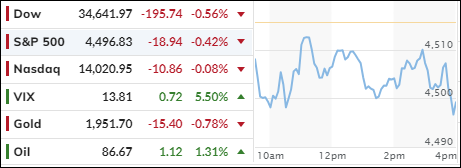
- Moving the markets
It was a tough Tuesday for stocks as they started the week with a drop, dragged down by rising oil prices. Saudi Arabia decided to keep cutting its oil production by 1 million barrels per day, pushing the West Texas Intermediate futures above $87 per barrel, the highest since November. That’s gotta hurt!
Meanwhile, Treasury yields also jumped, putting pressure on risk assets. The 10-year yield soared by more than 8 basis points to 4.258%.
Goldman Sachs tried to cheer up the market by lowering its recession odds to 15% and predicting that the Fed will skip a rate hike this month. But who are they kidding? September is usually a bad month for stocks, and investors know it.
Some traders are still hopeful that this year will be different, thanks to the bullish momentum. But history is not on their side.
Factory orders fell less than expected in July, down 2.1% versus a forecast of 2.3%. That’s not much of a consolation, though. The Fed still must balance inflation and growth, and rising oil prices won’t make it any easier.
The Fed wants a soft landing, but it could end up crashing. Small and midcap stocks took a big hit, with the S&P SmallCap 600, the S&P MidCap and the Russell 2000 all losing more than 1.8%. Value stocks also suffered their second worst day relative to growth since May.
Homebuilders and short sellers were not spared either, as bond yields spiked and hurt their portfolios. The gap between the 10-year yield and the Nasdaq keeps widening. Higher yields boosted the dollar, which weighed on gold. But don’t forget that gold usually beats stocks in recessions, as this chart shows.
So, what’s next for the market? Will it bounce back or continue to slide? Stay tuned for more updates.
2. “Buy” Cycle Suggestions
The current Buy cycle began on 12/1/2022, and I gave you some ETF tips based on my StatSheet back then. But if you joined me later, you might want to check out the latest StatSheet, which I update and post every Thursday at 6:30 pm PST.
You should also think about how much risk you can handle when picking your ETFs. If you are more cautious, you might want to go for the ones in the middle of the M-Index rankings. And if you don’t want to go all in, you can start with a 33% exposure and see how it goes.
We are in a crazy time, with the economy going downhill and some earnings taking a hit. That will eventually drag down stock prices too. So, in my advisor’s practice, we are looking for some value, growth and dividend ETFs that can weather the storm. And of course, gold is always a good friend.
Whatever you invest in, don’t forget to use a trailing sell stop of 8-12% to protect yourself from big losses.
3. Trend Tracking Indexes (TTIs)
The market opened lower, with only the Nasdaq holding up. The mood was gloomy, and no recovery was in sight.
Our TTIs, which tell us when to buy or sell ETFs, also fell with the rest of the market.
This is how we closed 09/05/2023:
Domestic TTI: +2.10% above its M/A (prior close +3.38%)—Buy signal effective 12/1/2022.
International TTI: +3.85% above its M/A (prior close +4.46%)—Buy signal effective 12/1/2022.
All linked charts above are courtesy of Bloomberg via ZeroHedge.
Contact Ulli